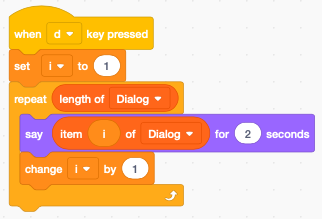Variables¶
Variables are places in the memory of the computer to store values. You can store numbers and strings.
Blocks¶
In a new project there exists already one global variable called my variable. You can use it, rename it or delete it.
When you activate the checkmark, the variable is displayed on the stage.
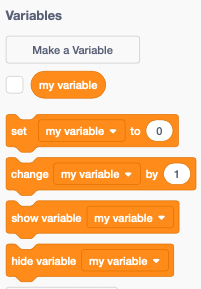
Set variable to¶
You can set a variable to a number value or to a string value. The following command will set the variable to the number value of 99.

To check the value of the variable you can drag a reporter block onto the programming canvas and click on it. The current value of the variable is displayed.

Change variable by¶
The change by block adds a number to the existing value. For example if the variable has been set to 99 and the change by 1 block is executed, then the new value of the variable will be 99 + 1 = 100.

If the variable contains a string value (such as abc), and you try to increment it, it’s value will be considered to be zero. After the change the variable has the value of the increment such as 0 + 1 = 1.
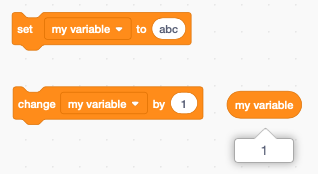
Display a variable¶
There are three ways to display a variable:
- normal readout, which has a label next to it
- large readout, without a label
- slider, the only way to modify the variable (works also on tablets)
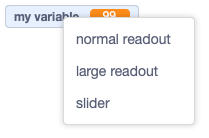
When you select slider there is an option to select the minimum and maximum value.
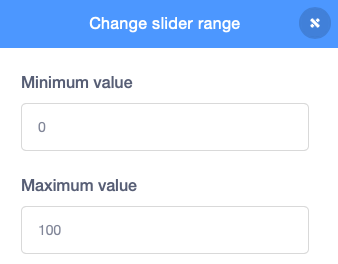
When a variable is displayed on the stage, you drag it with the mouse to the desired position.
However there is no way to do this with code.
Create a new variable¶
When clicking on the Make a Variable button you can create a new variable. In the example below we give it the name x.
You must also choose if this variable
- is available for all sprites,
- is available only this sprite.
You also can make it a Cloud variable which will be stored on the server. This feature requires to be logged-in.. It allows to create multi-player games.
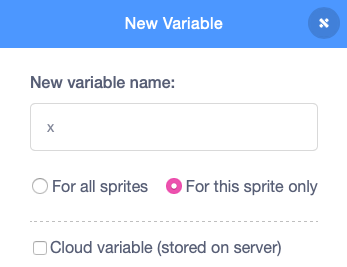
Rename or delete¶
All variable drop-down menus allow you to rename or delete them. You could delete or rename the my variable.
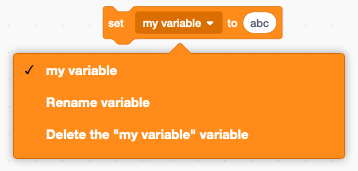
Global and local variables¶
When a variable is created for a single sprite only, it is called a local variable. Two local variables can have the same name. Variables which are available to all sprites are called global.
In the example below we have 3 variables:
- a global variable y
- a local variable x for the sprite Scratchy and
- a local variable x for the sprite Cake.
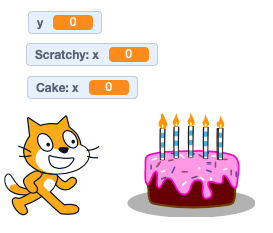
Stage variables are global and are available to all sprites.
Several reporter values can be displayed on the stage. Colors are used to distinguish them.
- orange for user-created global and local variables
- blue for sprite position and direction
- violet for sprite size
- purple for sound volume
- turquoise for global information such as the timer
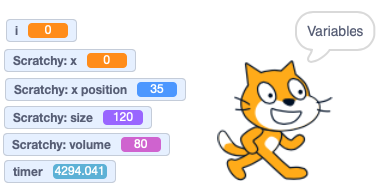
Your program can only show and hide the user-created variables (orange). The visibility of the other reporter variables can not be programmed.
Variable as a counter¶
A typical use of a variable is to be used in a loop as a counter. In that case we use the variable i. This stands for
- integer, or
- index
A counter loop consists of these blocks:
- set i to the initial value (often 1)
- enter a repeat loop
- do something with variable i
- change i by an increment (often 1)
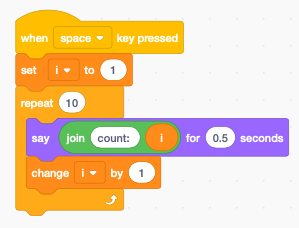
The above code makes Scratchy count from 1 to 10.
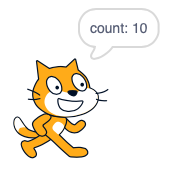
Largest number¶
The numbers which can be stored in variables are floating point numbers. They are called double-precision foating point numbers and are encoded internally with 64 bits. It has about 15 significant digits.
The largest number which can be represented is close to 1.8e308.
This value can still be used:
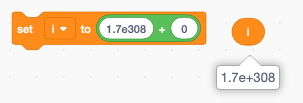
This slighty larger value results in Infinity.
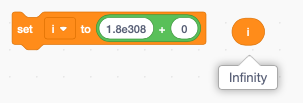
Make a list¶
Besides variables Scratch has a second way of storing information : lists. Lists are groups of variables.
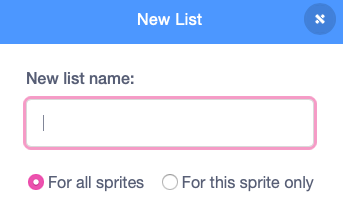
After making a new list you can display it on the stage.

This is the easiest way to enter data
- click (+) to create a new item
- click and drag (-) to resize the list
- when editing press ENTER to create a new item
The following image shows a list called Dialog with 3 items.
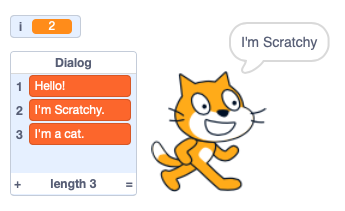
The image above shows index i = 2 accessing the item I’m Scratchy.
Cycle through a list¶
A frequent task is to cycle through all the elements of a list. Like in the counter example from before, we are using an index variable i.
The steps are
- initialize the index i to 1 (first item)
- repeat for the lenght of the list
- do something with the item number i
- change i by 1
